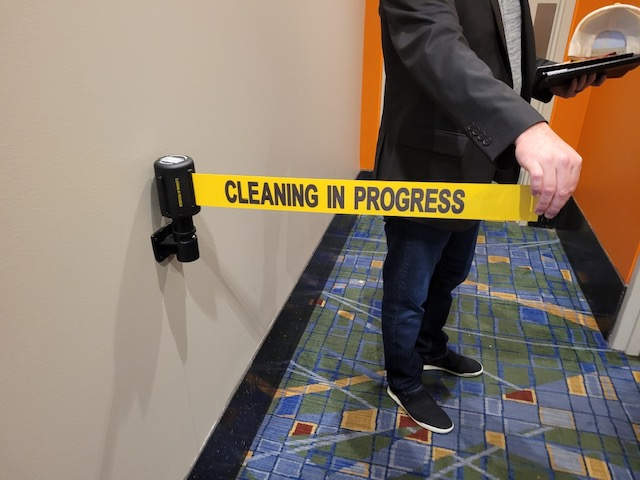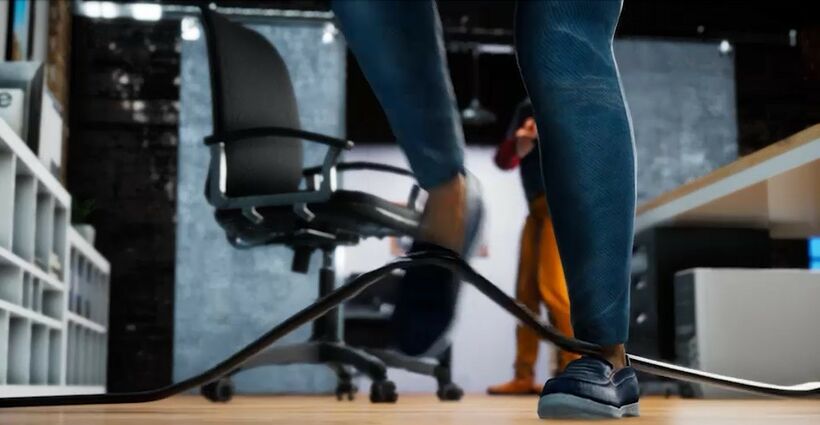Going up? Elevators, escalators, and stairways help us get from one level to another in a building with more than one story. Known in the architectural industry as "vertical transportation" - these methods allow for travel in between floors, but also come with potential hazards.
Let's breakdown the risks of all three methods and explore the safety measures you can take to prevent accidents from occurring.
Elevators
Modern elevators were first introduced in the 1920s. At the time, many people were apprehensive about traveling between floors in a small, windowless space, but today using an elevator has become second nature.
In the United States, you'll find elevators in nearly all buildings with three or more stories. This is because elevators allow mobility impaired people accessibility to the upper levels of a building with relative ease. In fact, the Americans with Disabilities Act (ADA) calls for an elevator to be installed if a building has three or more stories, or if each floor of the building exceeds 3,000 square feet.
The Risks
- Floor Not Level With Elevator: Entering and exiting an elevator can be hazardous, particularly if the floors are not level. If the floor of the elevator car is not exactly even with the floor of the building, there exists the potential for a hand, leg or piece of clothing to be caught in the gap between floor and car when the elevator doors start to close. Which is why it is so important for elevators to undergo regular maintenance checks to ensure the elevator cars are stopping level with all the floors. Employees should immediately report any time they notice a car not stopping evenly with the floor so that the elevator can be re-adjusted.
- Door Open Sign Not Easy To See or Not Working Properly : Modern elevators are designed with protective edges with sensors that trigger the door to reopen when touched. These sensors should be periodically tested to unsure they are working correctly. All elevators have a “door open” button, which reverses the doors to allow a slow moving person the time to enter or exit. It's imperative that this button has an easily understood icon or graphic symbol, to avoid someone pushing “door close” by mistake.
- Emergency Alarm Button/Phone Failure: A clearly marked alarm button inside the car should ring when pushed to signal that there is a problem with the elevator. In addition, each car should be equipped with a phone to call for help in the case of an emergency. Both of these essential safety features should be checked during regular maintenance.
The Importance of Regular Maintenance
Elevators have many moving parts that must be serviced on a regular basis to remain safe. Companies should have a regular maintenance schedule and a procedure in place to report any malfunctions noticed in between maintenance checks. Maintenance includes lubrication of moving parts, and repairing or replacing faulty or non-operating components. A highly visible safety barrier should always be used when elevators are being worked on to prevent unauthorized use during maintenance.
Traditional caution tape is not the best option for blocking an out-of-order elevator, as it can easily be ripped or fall down, creating a potentially dangerous situation where someone may not be aware that the elevator is broken and attempt to use it. A robust, easy-to-see safety barrier than cannot be torn is a much more effective way of blocking off an out-of-use elevator.
Consider scheduling a third party inspection to ensure your elevator is up to compliance standards.
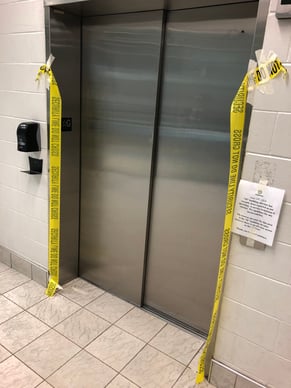
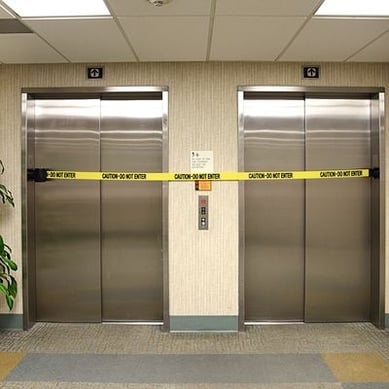
(Pictured Above: Traditional caution tape is too unreliable to be used to mark-off an out-of-order elevator. Instead, try using a durable, easy-to-read hazard communication barrier.)
Escalators
Unlike elevators, escalators are pretty simple yet fantastic machines. They are basically long conveyor belts, which pull stairs upward to make a moving staircase.
Escalators are ideally suited for high volume buildings such as shopping malls and airports but are not as practical for high rise buildings as they take up a lot of space and require more energy than other vertical transportation methods. Escalators can carry over 20 people simultaneously whereas most large elevators can only accommodate 10 to 15 passengers at a time.
The Risks
- Clothing, Body Parts, or Hair, Getting Caught in Stair Tread: Clothing, feet, fingers, hair and debris can all get caught at the edge between an escalator stair tread and the side panel - or between two treads when they flatten. This is a major risk of escalator use. A stop button, located at both the top and bottom of the escalator, allows passengers to stop the stairs to protect a trapped person from further injury. In such an emergency, the moving stairs come to a sudden halt, jolting riders. If people aren’t holding on to the rail, they can be knocked off their feet. Signs that remind riders to stand away from the edge and hold on to the rail can help keep employees and other riders safe. Escalators can be retrofitted with a strip of brush along the side panels just above where it meets the stairs; this prevents most objects from getting into the small gap.
The Importance of Regular Maintenance
Like elevators, escalators have many moving parts that must be serviced on a regular basis to remain safe. A regular maintenance schedule is key and a procedure to report malfunctions in-between maintenance checks is also important. Maintenance includes lubrication of moving parts, and repairing or replacing faulty or non-operating components. Temporary signs, barriers and operator control covers should be used to prevent unauthorized escalator use during maintenance operations.
According to the Elevator Escalator Safety Foundation, all escalators in the United States are manufactured and installed to be in compliance with the American National Standards Institute Safety Code. The code is updated every three years and requires that escalators be inspected regularly by specially trained and qualified inspectors. This is in addition to the regular maintenance that owners commonly contract with various elevator/escalator maintenance companies.
As with elevators, traditional caution tape is not the ideal option for blocking an out-of-order escalator, as it can easily be ripped or fall down. A strong safety barrier than cannot be easily torn is a much more effective way of preventing people from unwittingly using an out-of-order escalator.
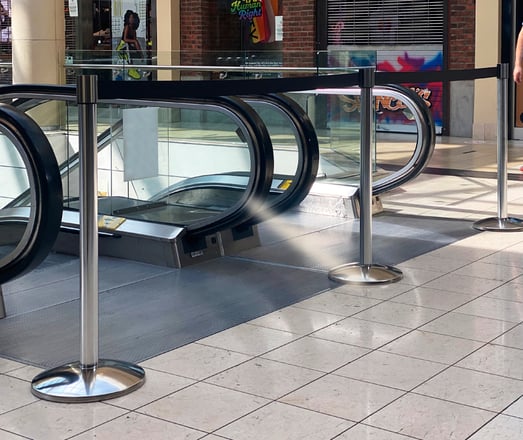
(Pictured Above: A physical barrier is an important tool in keeping people safe from out-of-order escalators. Often caution tape is not enough, as it is prone to tearing and/or falling down.)
Stairways
They may not be the most exciting means of vertical transportation, but there's a lot to be said about the good old fashioned stairs. For one, they can literally be life savers in the event of an emergency, such as a fire. During a fire, elevators and escalators typically stop working. Most are programmed to return to the ground floor when the fire alarm is triggered. Which is why all buildings with more than one story must have at least one set of stairs - to ensure all occupants can escape safely in the event of a fire.
Building codes also require exit stairwells with visible emergency exit signs. Stairwell doors should be heavy and the stairwell its self should be totally enclosed and well lighted to help protect people from smoke and fire.
Exit plans for handicapped individuals who cannot walk down stairs, should be incorporated into every organization’s emergency plans. Some options are having more able-bodied employees assigned to carry people down the stairs, or indicating a room to congregate where a point-person from the staff will hang a flag out the window to indicate to firefighters that special help is required for people in that room to exit the building. Those in authority may direct otherwise and their instructions should be followed.
Modern technology is great but if the electricity is turned off, or if for some other reason an elevator or escalator is not working, you always have the stairs to fall back on. Plus, they're the only method of vertical transportation that also make for a great workout.
The Risks
- Locked Stairwells: There are two main risks when considering a public stairwell - falls and getting locked into the stairwell area. Stairwells should remain unlocked, if possible, to prevent people from getting trapped. If, for security reasons, they need to be locked, then a procedure must be in place in the case of someone being stuck inside. Emergency phones or call buttons are a great tool.
- Falls: Falls can best be avoided with safety barriers. If a staircase is slippery from a spill, or being mopped, or is otherwise out-of-order, a physical barrier is a great asset to ensure people do not walk into harm's way and potentially fall.
.jpg?width=308&height=308&name=wall-mount-banner-stakes%20(4).jpg)
.jpg?width=308&height=308&name=wall-mount-banner-stakes%20(3).jpg)
(Pictured Above: Slippery or out-of-order stairs should always be blocked using a safety barrier to avoid injuries.)
Conclusion
Elevators, escalators, and stairways are an essential part of any multi-storied building. No matter which method of vertical transportation a facility uses, there are some potential hazards that should be considered. Prioritize safety in your building's vertical transportation systems with reliable procedures in place and regular maintenance checks. Preparedness beats panic, every time.
Safety barriers play an important role in accident prevention by alerting people when an elevator, escalator, or stairway is hazardous or closed for maintenance. Interested in including a safety barrier as part of your safety plan? We can assist you in finding the right product to suit your specific needs while meeting compliance requirements. Contact us today to get started!
Would you like help improving your worksite's over all safety program? We're here to help!
Schedule a site walk with us, and we'll build a safety plan tailored to your exact operations and layout.

